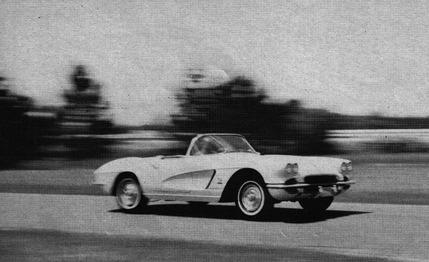
 Archived Road Test
Archived Road Test


Zora Duntov says that as far as he's concerned, this is the last time the Corvette's power will be increased — within the present chassis, anyway. It's a reasonable statement, since it's hard to discern a need for more poke than the booming new 327-inch Corvette V8 provides. The 360-horsepower fuel injection version more than makes good on the public relations promise of "added excitement for those wishing the ultimate in performance."
Recently we've always tested the hot fuel-injected version of the Corvette; we followed through on this with the '62 car. But in response to many requests from readers for data on a more normal go-to-market Corvette, we explored the opposite end of the range this year with the "small" (a miserable 250 horses) engine linked to the new aluminum-case Powerglide transmission. In this connection it's interesting that at Byrne Chevrolet's "Corvette Corral" in New York's Westchester County, the stock engine plus the four-speed box accounts for 80 percent of Corvette sales.
First, let's look at this new 327-cubic-inch engine, which makes official what hot-rodders have been doing to Chevys for years now. It's definitely based on the 283-inch engine design, keeping the same bore center-to-center distance of 4.40 inches while increasing the bore 1/8 inch to an even 4.0 inches. (Since the new Chevy II four and six have the same center-to-center distance, with redesign they too could presumably abide a four-inch bore.) Stroke is stretched 1/4 inch from the 283's 3.0 inches. Though the 327's rod length and bearing sizes are unchanged, the rod does have a heftier shank section to take the bigger engine's higher stresses. For the same reason all 327s have the heavy-duty aluminum Moraine bearings that were used only on the hot 283s before.
Last year's big-port head, with 1.94-inch intake valves, is now used on the top three of the four Corvette engine options. Only the base engine has the 1.72-inch intakes, fed by a normal four-barrel carb to deliver 250 bhp. The next hotter engine stays with the hydraulic-lifter cam but moves to the big-port head, and is equipped with a new oversized four-barrel Carter carb. Its output is 300 bhp, and it's still available with the Powerglide box. These two engines have double head gaskets for a compression ratio of 10.5 to one (actually about 10.2 to one); for the two top engines one gasket is pulled out to raise the c.r. to a nominal 11.25 to one, actual 11.1 to one. The Duntov solid-lifter cam is also fitted, output being 340 bhp with the big four-barrel and the aforementioned 360 with injection. The famed dual-quad layout, with all its complexities, is now entirely replaced by the new big Carter four-barrel.
Rochester fuel injection goes into its sixth year of production with a major change to adapt it to the deeper breathing requirements of the big V8. Instead of the old relatively complicated cold start arrangement, the new injector has a simple choke valve in a port in the center of the intake venturi plug. When this "strangler" valve is open, the total area made available is adequate to the engine's needs; when it's closed, it has a definite choking effect although the venturi itself — necessary for metering reasons — remains open. Control of the choke is fully automatic.